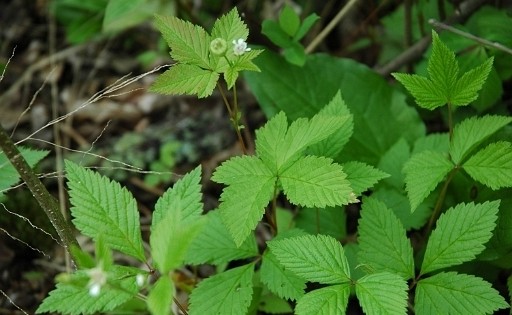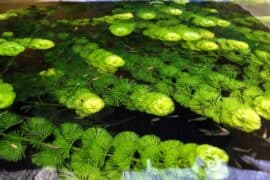Dwarf red blackberry
(Rubus chloocladus)

Description
Rubus pubescens (dwarf red blackberry, dwarf red raspberry, dewberry) is a herbaceous perennial widespread across much of Canada and the northern United States, from Alaska to Newfoundland, south as far as Oregon, Colorado, and West Virginia. Dewberry is known as a subshrub or herbaceous perennial (Kartesz 2011). The trailing stems (stolons) are 10 to 30 cm (4 to 12 in) in length, and the upright petioles are usually less than 20 cm (8 inches) tall. They differ from larger shrubby species in the genus in that the only upright part is herbaceous and only lightly speckled with fine hairs (hence the specific epithet pubescens), as opposed to the woody stems and larger prickles that cover many other species of Rubus Leaves are compound with three more or less sessile (stalk-less), diamond-shaped leaflets. The middle leaflet is the largest, and most symmetrical, while the two side leaflets are wider below the midrib; all leaflets have toothed margins. With the exception of the trailing stems, all parts of the plant are shed in the fall. Flowers have five white petals, often curled backwards, and the yellowish anthers give the center an appearance of yellow and black speckles. Flowering typically occurs between late May and late June, depending on the locality, but occasional flowers can be seen from early May through August. Flowers usually produce a single shiny red fruit, in the form of a cluster of drupelets (several tiny berries attached to a central receptacle), in early July. Like a blackberry, the fruit does not easily separate from its receptacle. Dewberry is found in moist conifer or mixed-wood forests, with canopies dominated by spruce and fir with lesser components of aspen, maple, birch, or pine. It roots primarily in the organic layers of the soil. It is often found growing with bunchberry (Cornus canadensis), wild lily of the valley (Maianthemum canadensis), and goldthread (Coptis trifolia). Dewberry is most common in boreal and temperate forested areas of Canada and the United States of America, but ranges from montane to coastal elevations, and from the arctic to the great plains, giving it a wide distribution in both north-south and east-west directions.
Taxonomic tree:







